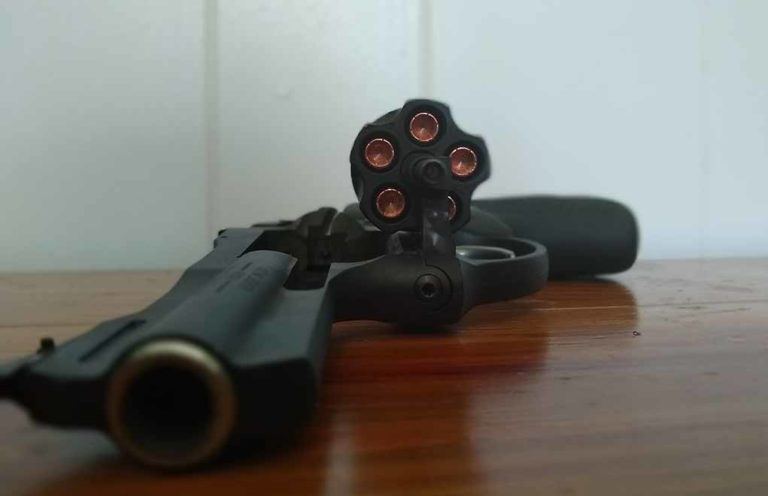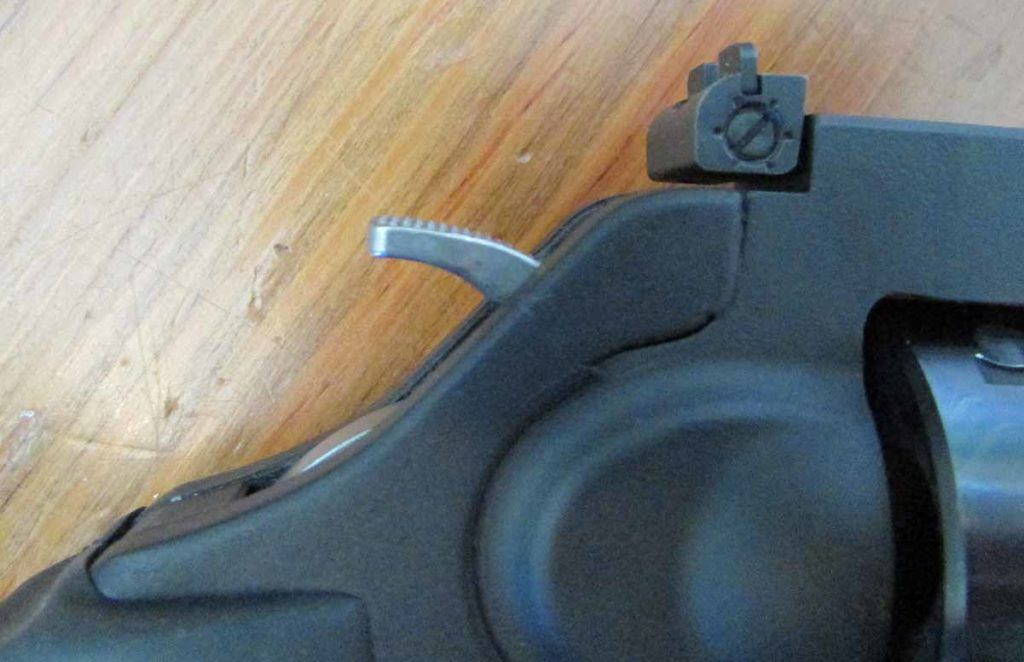
Ruger’s new 3-inch barrel LCRx in .357 Magnum strikes the right balance between concealability and performance.
How The 3-Inch Barrel LCRx Enhances The .357 Magnum:
- Longer 3-inch barrel improves the .357 Magnum's ballistics, while keeping the revolver concealable.
- Built with a stainless-steel frame, the LCRx still only tops out at 21 ounces.
- Hogue Tamer grip goes a long way in reducing the light revolver's recoil.
- Friction-reducing cam does much to mitigate the revolver's heavy pull in double-action.
Going on a century ago, Elmer Keith and Phil Sharpe were really onto something by hot-rodding the .38 Special. Arguably, their tinkering in the all-American pursuit of “more muscle” produced perhaps the greatest revolver cartridge of all time. At the very least, the .357 Magnum is the king of the 20th century. What other hand-cannon caliber is, in the same breath, both manageable and devastatingly powerful?
Certainly not the bucky .41 Magnum and the downright cranky .44 Mag. And while the newish .327 Fed. Mag. has the virtue of eminent shootability, it’s ballistically a small fry compared to the granddaddy Magnum.

advertised 1,450 fps, Sig Sauer’s 125-grain V-Crown performed well out of the LCRx’s 3-inch barrel with an average velocity of 1,281 fps.
It’s thanks to the .357 Magnum’s nearly perfect middle ground that the defensive revolver continues to soldier on. Despite the platform being dated in this era of semi-automatic pistols, a man or woman wielding a gun chambered for this cartridge is well armed—perhaps even more so, given the recent advancement in revolver design; and even more with Ruger’s latest addition to its easy-to-carry, ultra-lightweight line of revolvers.
Like the .357 Magnum, the 3-inch-barreled LCRx released at the 2019 SHOT Show strikes a perfect balance. Setting the fulcrum almost exactly between concealability and performance, Ruger has created a dandy wheelgun that flirts with being a nearly faultless carry revolver; one that’s certain to keep the age-old Magnum as relevant as ever in the 21st century.
That Extra 1.13 Inch
For some time now, Ruger has offered a .357 Magnum in both its hammerless LCR and exposed hammer LCRx lines. However, up to this point, these have featured the popular 1.87-inch barrel configuration: snubbies. It makes sense, given that when most folks go in search of a concealed-carry revolver, they generally poke around for the tersest model they can find. However, you can make the argument that they do themselves a disservice by going so small.

I can hear you now: Lord, he’s going to talk about recoil. Physics dictates nothing less in a lightweight gun. But for me, it’s not so much the knuckle-buster reputation that causes pause … it’s the muzzle blast and, more importantly, what that represents that raises flags.
The snubby .357 spits fire akin to a dragon for the simple reason that it doesn’t burn all its powder in the bore. This adds up to a gun that keeps the magnum’s bark and does away with some of its bite. By many accounts, a 1.87-inch-barreled revolver will neuter the .357 Magnum considerably—perhaps not to .38 Special+P velocities, as some gun-counter guys are apt to tell you, but well below what you expect or want out of a magnum.
Thankfully, a little goes a long way. While not topping out the .357 Magnum’s ballistic potential, extending the barrel to 3 inches revives a good deal of the cartridge’s magnum characteristics. It certainly did so in my time with the LCRx.

For example, the hottest round I shot was Sig Sauer’s 125-grain Elite Performance V-Crown, which clocked in at an average 1,281 fps, as measured by my chronograph 6 feet from the muzzle. Twice, the round topped out at 1,307 fps. Definitely, this is off the company’s numbers of 1,450 fps of muzzle velocity. Nonetheless, it was well within the bounds of .357 Magnum performance, which is what you want when you purchase a revolver with that roll mark.
The LCRx Package
The LCRx, for the most part, is meant to live a clandestine life. It was designed specifically for concealed carry, so Ruger did not spend time on shiny aesthetics that many have come to expect in modern revolvers. This isn’t to say the matte-black gun isn’t beautiful in its own right; it is, just in a different way. It’s attractive along the lines of a well-worn Carhart jacket, because it’s meant for work—hard work.
To that end, the most notable departure from its LCR and LCRx cousins is its monolithic frame’s upgrade to 400-series stainless steel. Aluminum has been the go-to material for a majority of the guns, but it just wouldn’t fit the bill for the abuse a .357 Magnum doles out.

While this pushes the five-round revolver’s weight up to around 21 ounces, the heft is welcome. First, because it’s far from prohibitive for carry. The .357 LCRx comes in lighter than most double-stack polymer pistols, even subcompact models. Yet, it’s enough weight to absorb the magnum’s recoil better than ultra-lightweight revolvers—snubbies or otherwise.
With a 3-inch barrel, the revolver has a decent sight radius. And Ruger gives shooters the tools to take advantage of it. The rear sight is an adjustable black blade. You can tune both drift and elevation with a small screwdriver. I packed my small set of drivers when I tested the LCRx, but the Ruger smiths were on their game and had it dialed in. While some might wring their hands about a potential snag, the sight is low enough so that it would take some doing to catch a shirttail or other garb.
In addition to this, the revolver boasts a pinned front ramp sight, meaning it’s replaceable—perhaps with a tritium night sight if you foresee trouble at dusk. However, if you stay stock, the inset white stripe proves highly visible, even in the gray and hazy conditions I used it in.

Famously, it’s extremely easy to change the grips on the LCR and LCRx: There’s only one retention screw to remove. However, I found the Hogue Tamer that came installed quite comfortable. The rubber grip’s pebble texture was akin to a coat of stick’um on the palm and kept the gun where I wanted it. Furthermore, it made the LCRx less punishing and more accurate, at least shot to shot, allowing me to maintain greater control on follow-ups.
The gun’s controls are also very intuitive. The hammer spur is laid back flatter than you will find on many revolvers. I’m certain that the reason is to streamline its draw. Even so, it’s easy to find when you want to cock it for a single-action shot. The cylinder release is push-button and situated for thumb operation, which I found second nature and fast on reloads—although the ejection rod was another matter.
Despite a full-length barrel lug, the ejector is short and only pushes spent cartridges halfway from the cylinder. Therefore, you must keep in mind to tilt the revolver back to clear it completely (a review of Massad Ayoob’s “stressfire” technique to clear the gun might be in order).

Finally, the LCRx has an ample trigger guard, which was a godsend for my testing. With the last throws of winter blustering across the prairie, I wore gloves for my range time and was completely unimpeded.
Expand Your Knowledge on the Legendary .357 Magnum
- Choosing the Best .357 Revolver for Your Needs
- Pros and Cons Explored: Is .357 Magnum Good for Self-Defense?
- Exploring Pistol-Caliber Rifles – Is .357 Magnum the Best Option?
- Top Features of a .357 Snub Nose Pistol for Self-Defense
Dropping The Hammer
For my range test of the 3-inch-barrelled LCRx, I shot three different defensive rounds—including one in .38 Spl +P—and a full metal jacket round. These included Sig Sauer 125-grain Elite Performance V-Crown, Federal 130-grain HST .38 Spl. +P, Sig Sauer 125-grain FMJ and Speer 158-grain Gold Dot JHP.
In all cases, the ammunition/gun combinations proved highly accurate, perhaps more so than my numbers reflect. The elements might have squeezed in a fraction of an inch here or there; nevertheless, from 15 yards off a rest and in single-action mode, I was capable of groups 2.25 inches or under across the board with .357 ammo.

The best performance, however, came from Gold Dot. The heaviest round punched a tidy, five-round group just off center mass that measured 1.06 inches—more than accurate, given the conditions and for self-defense.
The revolver’s single-action trigger is solid, breaking at about 6 pounds. It’s certainly not a polish job by any stretch of the imagination, but for an out-of-the-box carry gun, it is very nice.
The 10-pound double-action, however, is what caught my attention. Much has been written about Ruger’s friction-reducing cam in the LCR and LCRx revolvers; that is, how smooth it is and how there’s never a second thought about the trigger stacking. I’m here to say that it’s all true.

Yes, it’s a heavy pull (what did you expect in double-action?), but—my goodness—it’s like silk! And, I saw the results in the accuracy I achieved on rapid-fire strings from 7 yards. Consistent and smooth go a long way in overcoming heavy.
Parting Shot
A barbecue gun it is not. The 3-inch-barreled LCRx in .357 Magnum is all business and meant to excel in a cutthroat world.
Because it maintains the dimensions of a neat, little (it still qualifies as this) carry gun while bringing out the best in the powerful cartridge, the LCRx is just about everything you’d want out of a defensive .357 Mag. If you go this route, as did nearly a century of Americans before you, you won’t be under-gunned.
The article originally appeared in the June 2019 issue of Gun Digest the Magazine.
Get More Ruger Info:
- Great Ruger Guns
- Ruger No. 1
- Ruger Precision Rifle
- Ruger Redhawk
- Ruger Super Redhawk
- Ruger Blackhawk
- Ruger Single Six
- Ruger 10/22
- Ruger LCR
- Ruger 77/22
- Ruger 77/44
- Ruger SR1911
- Ruger Hawkeye
- Ruger Mark IV
- Ruger SR-556
- Ruger LCP II
- Ruger American Magnum
- Ruger American Rifle
- Ruger Gunsite Scout Rifle
- Ruger SR-762
- Ruger Red Label
- Ruger SR40
- Ruger Single Nine
- Ruger P345

Next Step: Get your FREE Printable Target Pack
Enhance your shooting precision with our 62 MOA Targets, perfect for rifles and handguns. Crafted in collaboration with Storm Tactical for accuracy and versatility.
Subscribe to the Gun Digest email newsletter and get your downloadable target pack sent straight to your inbox. Stay updated with the latest firearms info in the industry.

![Best Concealed Carry Guns In 2025 [Field Tested] Wilson Combat EDC X9S 1](https://gundigest.com/wp-content/uploads/Wilson-Combat-EDC-X9S-1-324x160.jpg)


![Best 9mm Carbine: Affordable PCCs [Tested] Ruger Carbine Shooting](https://gundigest.com/wp-content/uploads/Ruger-Carbine-Shooting-100x70.jpg)
![Best AR-15: Top Options Available Today [Field Tested] Harrington and Richardson PSA XM177E2 feature](https://gundigest.com/wp-content/uploads/Harrington-and-Richardson-PSA-XM177E2-feature-100x70.jpg)
